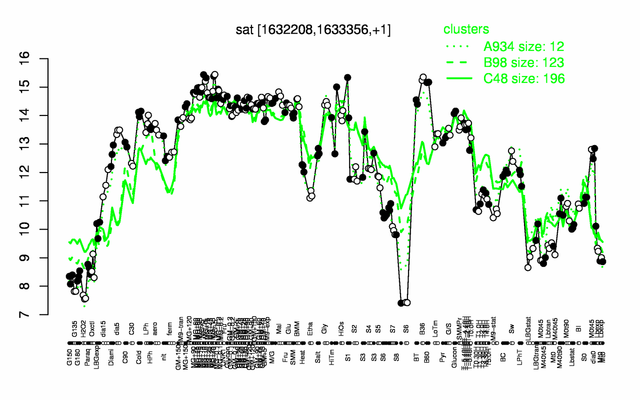Sat
Revision as of 09:28, 17 April 2014 by 134.76.70.252 (talk)
- Description: sulfate adenylyltransferase
| Gene name | sat |
| Synonyms | ylnB |
| Essential | no |
| Product | sulfate adenylyltransferase |
| Function | sulfate activation |
| Gene expression levels in SubtiExpress: sat | |
| Metabolic function and regulation of this protein in SubtiPathways: sat | |
| MW, pI | 42 kDa, 5.646 |
| Gene length, protein length | 1146 bp, 382 aa |
| Immediate neighbours | cysP, cysC |
| Sequences | Protein DNA DNA_with_flanks |
Genetic context 
This image was kindly provided by SubtiList
| |
Expression at a glance PubMed
| |
Contents
Categories containing this gene/protein
sulfur metabolism, most abundant proteins
This gene is a member of the following regulons
The gene
Basic information
- Locus tag: BSU15590
Phenotypes of a mutant
Database entries
- BsubCyc: BSU15590
- DBTBS entry: [1]
- SubtiList entry: [2]
Additional information
The protein
Basic information/ Evolution
- Catalyzed reaction/ biological activity: ATP + sulfate = diphosphate + adenylyl sulfate (according to Swiss-Prot)
- Protein family: sulfate adenylyltransferase family (according to Swiss-Prot)
- Paralogous protein(s): YitA
Extended information on the protein
- Kinetic information:
- Modification:
- Effectors of protein activity:
Database entries
- BsubCyc: BSU15590
- Structure:
- UniProt: O34764
- KEGG entry: [3]
- E.C. number: 2.7.7.4
Additional information
Expression and regulation
- Regulation:
- Regulatory mechanism:
- S-box: transcription termination/ antitermination, the S-box riboswitch binds S-adenosylmethionine resulting in termination PubMed
- CymR: transcription repression
- Additional information:
- belongs to the 100 most abundant proteins PubMed
- number of protein molecules per cell (minimal medium with glucose and ammonium): 3105 PubMed
- number of protein molecules per cell (complex medium with amino acids, without glucose): 3780 PubMed
Biological materials
- Mutant:
- Expression vector:
- lacZ fusion:
- GFP fusion:
- two-hybrid system:
- Antibody:
Labs working on this gene/protein
Isabelle Martin-Verstraete, Institute Pasteur, Paris, France
Your additional remarks
References